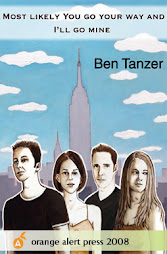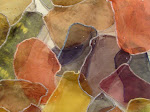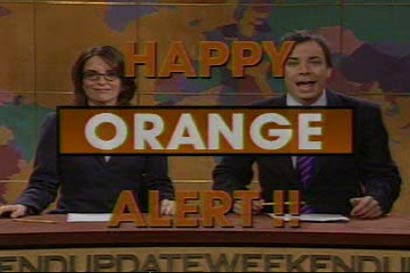
Michael Paige Glover
When I saw that the fourth of July fell on a Wednesday this year I was overjoyed, and I made it my mission to find an artist the exemplified Orange Alert on the fourth of July. I wanted Americana, I wanted the American dream, the suburbs, the cities, but I wanted them in complex situations. I want to see the classic images of days gone by meshed with modern tragedy, innocence with chaos. I wanted Michael Paige Glover.
Michael Paige Glover currently lives in Brooklyn, NY, but he grew up in Decatur, AL. After completing his undergraduate degree in Graphic Design in 1996, he traveled to Venice, France for an apprenticeship with Nall Hollis at the N.A.L.L Art Association. Afterward, Glover studied with Italian Artist Andrea Spinelli in Florence Italy for 6 months. The artist received his MFA in Figurative Painting at the New York Academy of Art in 2001. He has participated in many group and solo shows in New York and across the country.
Michael recently completed his latest collection of pieces and took some time out to talk to us about his new work.

Orange Alert (OA): How would you describe your work?
Michael Paige Glover (MPG): My work can be described as kind of dysfunctional Americana that uses familiar imagery to tell a story. At first glance, it arouses a feeling of nostalgia and the good old days so-to-speak but woven into that idealism is a haunting or menacing presence. There is a contrast of innocence in youth verses the anxiety of adulthood and also, psychological themes which hint at the darker side of the suburban family. Adults and Children are juxtaposed or morphed into a background of chaos, destruction, or ambiguous imagery. I cut and paste images in photoshop and spend hours upon end arranging them and building compositions.
OA: What was the inspiration behind your latest series of paintings?
MPG: I had been playing with the idea of the typical American Dream going up in flames. People rush to the alter without finding out who they really are: you get the job, the car, have kids and think you are finally complete as an adult but a few years down the road, when you haven't really taken stock in yourself, you realize that the house with the white picket fence was just an illusion. I experienced a similar situation and I was at a turning point in my life where everything was changing. I realized the work I had previously made was not what I wanted to really express as an artist. So, I went back to the things that really interested me, the things that held my attention, so I began mixing nostalgic, 2-D illustration with hyper realistic images from various photo resources and films. For a long time, I had been collecting vintage photographs and magazines from flea markets, antique stores and basically anywhere you can imagine. It was like an obsession. They were images of random places and random people but there was an authenticity to them that kept begging to be painted in a meticulous manner. It turned into a passion actually and although the imagery is dated, it was fresh to me and I wanted to combine it with other elements that were not-so-dated. It was a liberating experience to combine all of these great images and develop a personal narrative that somehow relates to my life. It also has to do with growing up in a very religious environment in the South.
It was like creating a kind of finely detailed madness but an appreciation for the madness, if that makes sense.
OA: Do you have a specific color palette that you work from? Do you consciously try to evoke a specific theme or emotion through use color or is that the responsibility of the images?
MPG: I tend to use color both intuitively and consciously because it leads me to make accidental discoveries and develop combinations that I normally would never use. Other times, I already have the colors planned out and it's just a matter of using the right blue or green to compliment a crimson or a lavender. Cool tones vs warm tones. People have commented in the past that my colors evoke a lot of emotion and so I think it's something that comes out naturally. It has to have a visual impact on me before I can proceed with the next step and if not, I'll keep working at it until it feels right visually and emotionally.

OA: Who are some of your biggest influences artistically?
MPG: The filmmaker Terrence Malick is one of my influences because his visual compositions are so overwhelmingly beautiful and have a quiet but intense appreciation for nature. His characters are also mysterious, simple and at the same time, very complex human beings.
The Caprichos aqua tints, The Disasters of War and the Black Paintings of Francisco de Goya have been an undeniable resource as well.
Richard Scarry's children's books were some of the first books I remember seeing as a child and they still have an affect on me today. The aerial perspective of the towns and villages and the little characters are so unique. You can get lost in that world.
Also, I feel very in tune with the art that's currently coming out of the West Coast, especially in Los Angeles.
OA: In the last few years there has been a huge increase in the acceptance of illustrators into the art community and galleries. Where do you think the illustrator fits into the art scene, and why has the popularity grown?
MPG: I think illustrators bring a new life to the contemporary art scene because they are coming from a different perspective than fine artists. It seems they are more liberated in some respects, especially with the combination of traditional drawing, painting and collage techniques. It's not all commercially driven anymore. Making work for commercial reasons is one aspect of illustration but it no longer "defines" the illustrator as a whole, as it did in the past. It seems that for a long time, there was a huge rift between what is considered "fine art" and what's considered "illustration" and one could not mix with the other. Collectively, I think artists of all disciplines have grown a little tired of this debate. It's become an outdated concept in my opinion. I think the popularity has grown because boundaries have been broken down and Illustrators are simply doing what they want to do (like having solo gallery shows), instead of doing what's expected of them.
OA: I read in your blog that you "paint like a turtle or like Winnie the Pooh would paint". What is your typical starting point for a new piece and how long does it take to complete that piece? How long did you spend on the 15 pieces in your new collection?
MPG: Yes, my technique is very calculated and methodical and I don't know if that's an advantage or disadvantage. I wish it were more spontaneous at times. I can only go at my own pace, sort of like a turtle I guess. It's a lot of layering, glazing, overlapping, reworking and scumbling of the paint. I try to let each piece evolve on it's own and not force anything. If Winne the Pooh were a painter, he'd probably take forever to finish a piece and that's why I made the reference. I can imagine all of his friends around him saying " Are you finished yet?, you've been working on that thing for 3 months! what's taking so long?" But Pooh knows that he has to work in his own concentrated way and so he's content to put up with his friend's Bullsh*t.
I actually paint a little faster now simply because I have to get the ideas out or it drives me crazy. Before, I would over analyze the idea to death and paint on it forever.
I start out with several composed pictures and along the way, it changes into something else. I add things and take things away. I make an under painting and I focus on getting the drawing right from the beginning. I generally spend about two to three weeks on a large painting depending on how crazy my life is at the moment.
I recently had the opportunity to take time off for 3 months and paint full time. I worked about 6 to 8 hours a day and made about one large painting every one or two weeks. It was a productive time but I did suffer a little burn out. I've been working on this new series for about a year and a half. The first pieces were a completely different direction for me, so I let the creative process unfold naturally. Now, it seems to flow much smoother and each painting gives life to a new one.

OA: What is next for Michael Paige Glover?
MPG: I have a group show coming up at Aidan Savoy Gallery in New York City July 12th, and I'm exhibiting with very talented people, so it's going to be a great show.
Eventually, I plan to transfer this "Dysfunctional Americana" theme into a graphic novel, which will be somewhat autobiographical but it's still a long work in progress. I'm anxious to continue the progression of this work and put it out there for people to see.
Bonus Questions:
OA: Coffee? If yes, what is your favorite type of coffee and where is your favorite coffee spot? MPG: I'm a sucker for Irish Cream flavored coffee but I usually end up buying a brand called "Cafe Bustello" which is an espresso style coffee. My favorite spot is in front of my computer early in the morning, sipping and browsing.
OA: Do you listen to music while you work? Who are some of your favorites while working and in general?
MPG: My ipod is my musical Bible while painting. Lately I've been listening to Helmet, Thom Yorke, Keane, Morrissey, Beastie Boys, Tool and a lot of 90's music.
For more information on Michael Paige Glover please visit his website.
+by+Nick+Volkert).jpg)





















4 comments:
Usually I do not post comments on blogs, but I would like to say that this blog really forced me to do so! Thanks, for a really nice read.
Wow!! In reality I‘ve discovered a perfect platform to find out exact information
I enjoy reading article. Hope i can find more articles like this one. Informative post, I try to follow your tips. Thanks for posting.
Nice to be visiting your blog again, it has been months for me. Well this article that i’ve been waited for so long. I need this article to complete my assignment in the college, and it has same topic with your article. Thanks, great share.
advertising | top advertising agencies in Pakistan | Marketing Agency | Advertisement
Post a Comment